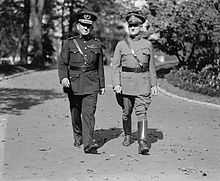Charles S. Farnsworth
| Charles Stewart Farnsworth | |
|---|---|
 MG Charles S. Farnsworth, right, with Marine Commandant John A. Lejeune at the White House, October 20, 1924. | |
| Born |
October 29, 1862 Lycoming County, Pennsylvania |
| Died |
December 19, 1955 (aged 93) the Naval Hospital in Norco, California |
| Allegiance | United States of America |
| Service/branch | United States Army |
| Years of service | 1887 - 1925 |
| Rank | Major General |
| Commands held |
159th Infantry Brigade 37th Infantry Division |
| Battles/wars |
Spanish-American War World War I *Battle of Saint-Mihiel *Meuse-Argonne Offensive |
| Awards |
Distinguished Service Medal Silver Star Croix de guerre with Palm (from France) Légion d'honneur (from France) Order of Léopold (from Belgium) |
Charles Stewart Farnsworth (October 29, 1862 – December 19, 1955) was an American general and civic leader.
Early life
Farnsworth was born in Lycoming County, Pennsylvania and attended local public schools. He worked for Western Union and the Bell Telephone company before being appointed to the United States Military Academy in 1883.[1]
Military career
After graduating in 1887, Farnsworth was sent to various posts in the Great Plains. He was stationed at Fort Sisseton in South Dakota, Fort Shaw in Montana, and Fort Buford in North Dakota. While at Fort Shaw, he married Laura Galey. They had one son, Robert. She died in 1890.
In 1893 he became Professor of Military Science and Tactics at the University of North Dakota. In addition to his teaching job, Farnsworth was also head coach of the North Dakota Fighting Sioux football team from 1895 to 1896. In 1894 he married Helen Bosard of Grand Forks, North Dakota. They had no children.
During the Spanish-American War, Farnsworth served as a quartermaster in Cuba and was an aide to Adna Chaffee.
After the war, Farnsworth was sent to Alaska where he founded and constructed Fort Gibbon. He was then sent to the Philippines where he founded and built Fort William McKinley. He also expanded the cantonments at the Presidio of San Francisco.
In 1909, he attended the Command and Staff College. He graduated from the Army War College in 1916.
During the Punitive Expedition into Mexico, Farnsworth served as a battalion commander and supply base commander.
Farnsworth was the commandant of the Infantry Training School at Fort Sill at the beginning of World War I. He then commanded the 159th Infantry Brigade at Camp Lee, Virginia.
In 1918, Farnsworth was promoted to major general and placed in command of the 37th Infantry Division of the Ohio National Guard. He brought the division to France, where it participated in the Battle of Saint-Mihiel and the Meuse-Argonne Offensive.
For his service during World War I, Farnsworth received the Distinguished Service Medal and the Silver Star medal. He also received the Croix de guerre with Palm and the Légion d'honneur from France. From Belgium, he received the Order of Léopold.
After World War I, he commanded Camp Bowie in Texas before being ordered to Fort Benning. There, Farnsworth organized the United States Army Infantry School and served as its first commandant. In July 1920, Farnsworth became Chief of Infantry. He served in that position until his retirement in 1925. As Chief of Infantry, Farnsworth traveled around the country inspecting reserve units and R.O.T.C. programs. He also reviewed reports by junior officers George S. Patton and Dwight Eisenhower on infantry tactics and the use of armor. Farnsworth dismissed both reports. Farnsworth retired on March 27, 1925.[2]
Later life and civic leadership
Farnsworth and his wife moved to Altadena, California after his retirement and lived on Las Flores Drive, close to his son. They became involved in the community. Gen. Farnsworth was the president of the Altadena Citizens' Association and the Altadena Beautification League. He sat as president of the board of the La Vina Sanitorium. He was also a member of the Los Angeles County Planning Commission and the Criminal Complaints Committee of the Los Angeles County Grand Jury.[3]
In 1931, Farnsworth was Grand Marshal of the Tournament of Roses and was one of a few to ride a horse down the parade route in modern times.[4]
Farnsworth was instrumental in the creation of Altadena Park in 1934. Farnsworth led the fundraising, designed the park, and supervised its grading and landscaping. The park was renamed in his honor in 1939.[5]
His wife died in 1951. He died in 1955 at the Naval Hospital in Norco, California. They are both buried at the cemetery at the Presidio of San Francisco.[6]
The Farnsworth Family Papers (Robert J. Farnsworth and Charles S. Farnsworth) collection is housed in the Rasmuson Library Archives, University of Alaska Fairbanks.
Notes
- ↑ "In Memory",Assembly, Association of Graduates, U.S.M.A., April 1956, p. 57; "Milestones", Time, January 2, 1956, p. 57.
- ↑ Assembly, p. 57.
- ↑ Assembly, p. 57; Michele Zack, Altadena: Between Wilderness and City, Altadena, California: Altadena Historical Society, 2004, p. 148.
- ↑ Assembly, p. 57; "Rose Parade Head Named", Los Angeles Times, December 16, 1930, Part II, Page 2.
- ↑ Robert H. Peterson, Altadena's Golden Years Alhambra, California: Sinclair Printing and Litho, Inc. 1976., pp. 92-93
- ↑ Assembly, p. 57; "Milestones", p. 57
References
- "Milestones". Time, January 2, 1956, p. 57.
- "In Memory". Assembly, Association of Graduates, U.S.M.A. West Point, New York: United States Military Academy, Vol. XV, No. 1, April 1956, p. 57.
- Peterson, Robert H. Altadena's Golden Years Alhambra, California: Sinclair Printing and Litho, Inc. 1976.
- "Rose Parade Head Named". Los Angeles Times, December 16, 1930 Part II, p. 2.
- Zack, Michele. Altadena: Between Wilderness and City Altadena, California: Altadena Historical Society, 2004 ISBN 0-9747257-0-6
External links
| ||||||
|